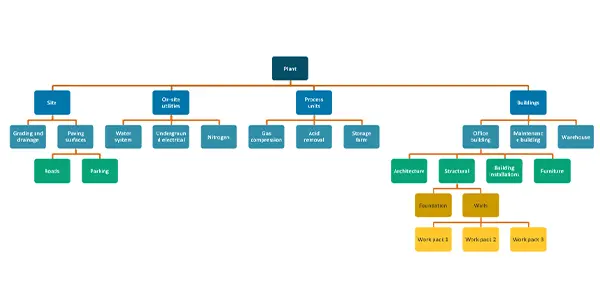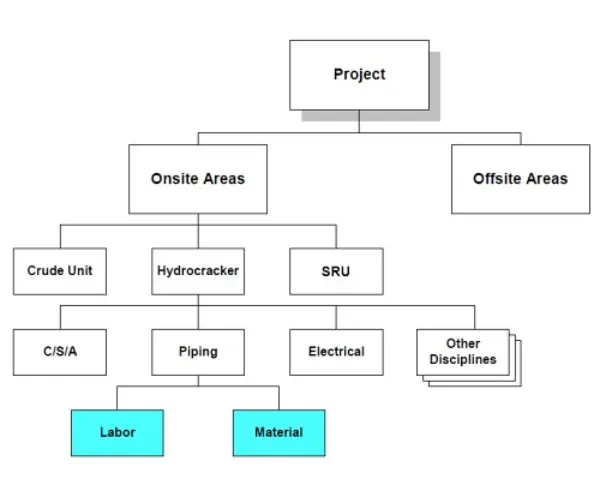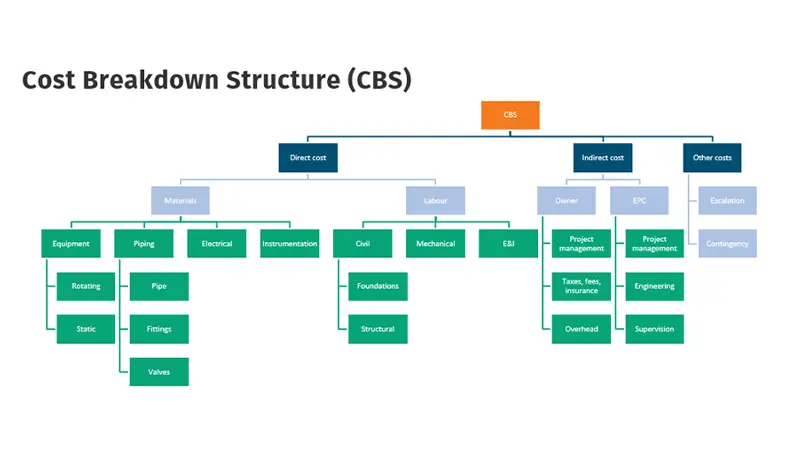
A well-defined Work Breakdown Structure (WBS) forms the cornerstone of every high-performing cost control department. It gives a clear structure that links project scope, cost, and time. This ensures that every deliverable is well-defined and easy to track during the project.
However, confusion often arises between WBS and other breakdown structures such as the Cost Breakdown Structure (CBS), Area Breakdown Structure (ABS), or Resource Breakdown Structure (RBS) due to terminology. This confusion leads to poorly defined WBSs, resulting in significant project consequences as it impacts the entire project transparency during execution.
In this article, we’ll explore what a WBS is, how to structure it, and why it plays a critical role in project management.
Understanding the Concept of a Work Breakdown Structure
A WBS is one of the first and most critical steps in project planning, defining how work is structured, visualized, and managed. Thus, it serves as the foundation for scope, cost, and schedule control.
At a conceptual level, a WBS helps project teams see the “big picture” by breaking the overall project scope into smaller, more manageable parts. This structured decomposition allows teams to understand what needs to be done, how it fits into broader objectives, and who is responsible for each part.
Definition of a Work Breakdown Structure (WBS)
According to the Project Management Institute (PMI), a WBS is a “deliverable-oriented hierarchical decomposition of the work to be executed by the project team.”
In simpler terms, a Work Breakdown Structure (WBS) is a fundamental data view structure that breaks down a project into smaller, more manageable components. It is a hierarchical structure in which the total scope of work is decomposed to represent the deliverables as small engineering or work packages.
Once created, the structure is agreed upon by all stakeholders and serves as the backbone for scheduling and cost management of one project or preferably multiple projects.
Types of Work Breakdown Structures
According to PMI, there are two main types of Work Breakdown Structures in project management:
Deliverable-based WBS
This WBS structure organizes the project based on deliverables or outcomes. Each branch represents a tangible output, such as a system, facility, or report. Thus, deliverable-based WBS align well with engineering and construction projects where end products are clear.
Phase-based WBS
This WBS structure organizes the project according to its lifecycle phases, such as initiation, planning, execution, monitoring, and closure. Therefore, it is commonly used in projects that are managed in distinct sequential stages.
Note that in practice, many organizations use a hybrid approach that combines both WBS types. For instance, structuring by deliverables at the top level and by phase or discipline at lower levels. Blending approaches can enable better alignment between planning, execution, and control.
Levels of a WBS

A Work Breakdown Structure is organized into multiple levels, each providing increasing detail about the project deliverables and tasks. Project teams often consider dependencies between tasks at each level to ensure a logical flow of work. Here’s a brief overview of the typical WBS levels:
Level 1: Project goal
The top level of the WBS represents the overall project goal or final deliverable. This is the broadest level and provides a high-level view of what the project aims to achieve.
Level 2: Major deliverables or phases
This level breaks down the project goal into major deliverables or phases. Each major component represents a significant part of the project, such as project phases, milestones, or major deliverables.
Level 3: Sub-deliverables
In level 3, the team further breaks down major deliverables into sub-deliverables to provide more detail. These are smaller components that contribute to the completion of each major deliverable.
Level 4 and below: Engineering/Work packages
At the lower levels, the project team decomposes sub-deliverables into work packages. These are the smallest units of work in the WBS, detailed enough to be assigned to discipline experts, project stakeholders or contractors. These components contain specific tasks that need to be completed to achieve the higher-level deliverables.
As project teams develop work breakdown structure levels, they further clarify the required work to achieve the project objective. Project managers can incorporate additional levels into the WBS, depending on the desired level of detail/span of control. This flexibility allows for a tailored visualization of the project structure, aiding in thorough work package planning and execution.
Importance of Using a Work Breakdown Structure
A WBS sets the foundation for effective project execution, transparency, and control. It provides a clear, hierarchical framework that defines and organizes the total project scope into manageable components.
By breaking complex projects into smaller and structured elements, the WBS ensures every deliverable and activity aligns with project objectives. This helps teams to plan, execute, and track progress efficiently across all disciplines.
Furthermore, when integrated with other breakdown structures, such as the Organizational Breakdown Structure (OBS) and Cost Breakdown Structure (CBS), the WBS forms the backbone of integrated project controls. When put together, these structures enable the creation of a Responsibility Assignment Matrix (RAM), which links work packages to accountable teams and stakeholders.
This integration enhances visibility, coordination, and control, allowing cost and schedule performance metrics like the Cost Performance Index (CPI) and Schedule Performance Index (SPI) to be accurately monitored through Earned Value Management (EVM). Therefore, the WBS defines work, but also connects scope, cost, and schedule to ensure every part of the project is delivered efficiently and transparently.
Key WBS Benefits in Project Management
Here are some key benefits of using a WBS in project management:
- Improved Project Clarity and Scope Definition: A well-structured WBS ensures that all stakeholders understand the project deliverables, ownership, and timelines, reducing ambiguity and scope creep.
- Enhanced Cost and Schedule Control: By linking cost and time data to specific work packages, the WBS allows for precise cost estimation, forecasting, and variance analysis, forming the basis for accurate project control.
- Better Communication and Accountability: Integrating the WBS with a Responsibility Assignment Matrix clarifies roles, promotes accountability, and strengthens communication across project teams.
- Resource Planning and Optimization: The WBS provides visibility into required resources per work package or discipline, helping managers allocate resources effectively and reduce inefficiencies.
- Risk Identification and Early Detection: Because the work is broken down into clear, measurable components, potential risks can be identified and mitigated early in the project lifecycle.
- Supports Earned Value Management (EVM): When integrated with cost and schedule data, the WBS enables ongoing performance tracking using EVM metrics like CPI and SPI, allowing proactive corrective actions when deviations occur.
Tips for Creating an Effective Work Breakdown Structure
To create a high-quality project Work Breakdown Structure, it helps to follow a structured and consistent work procedure. Doing so helps avoid mistakes and justify specific choices made.
Here’s a practical approach to developing a WBS:
- Decompose the project scope (or portfolio scope) of work into deliverables
- Specify the desired hierarchy (process, organization or product)
- Represent the entire project by a specific “project block”
- Specify the appropriate level of detail the WBS should contain
- Branch out beneath the project block into several levels and components which are equal to the total project scope when combined
- Review and refine for future projects
Furthermore, a project Work Breakdown Structure is only as effective as its usability. Even the most logically designed WBS can fail in practice if it lacks clarity, consistency, or traceability. That’s why using clear and standardized coding and labeling conventions is essential. A consistent coding system allows every stakeholder, from cost engineers to schedulers, to understand how to interpret the WBS, track progress, and identify where each activity fits within the overall project. It also ensures that resources are allocated accurately and that performance data can be rolled up or analyzed across multiple project levels.
Additionally, while you might feel tempted to give as many details as possible, it is important to consider the span of control. If the WBS is too high-level, you lose visibility into the work that truly matters. However, if it’s too detailed, it becomes difficult to manage, maintain, and communicate effectively. Striking the right balance keeps the WBS clear, actionable, and easy to control.
From experience, many project control specialists find that stating and defining the WBS within a project controls software, such as Cleopatra Enterprise, greatly enhances accuracy and efficiency. Such tools automate the linking of cost accounts, schedules, and progress data to WBS elements, reducing manual errors and improving transparency across the project lifecycle.
Effective project cost tracking is essential to staying on budget and making informed decisions. This guide explains how…
Operational efficiency in project management is about achieving more with less: delivering projects on time and within budget…
Related resources
Defining and Creating Resource Breakdown Structures (RBS)
In this blog, we look at Resource Breakdown Structures, how to create them, their benefits, and practical tips for implementation.
Read blog article
What is a Cost Breakdown Structure (CBS)? Applicability and Challenges
In project management, a Cost Breakdown Structure (CBS) is a vital view used to organize and track expenses throughout a project’s lifecycle. Learn its key components, uses in cost management, and the challenges involved in applying it effectively.
Read blog article